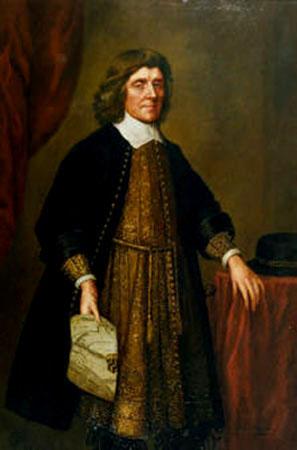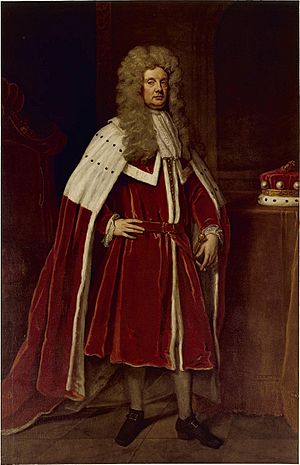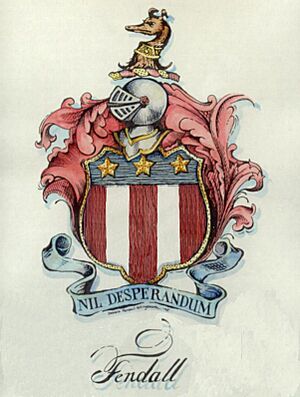Josias Fendall facts for kids
Quick facts for kids
Josias Fendall
|
|
|---|---|
| 4th Proprietary Governor of Maryland | |
| In office July 10, 1656 – June 24, 1660 |
|
| Preceded by | William Stone |
| Succeeded by | Phillip Calvert |
| Personal details | |
| Born | 1628 |
| Died | 1687 |
| Nationality | English |
| Signature | |
Josias Fendall (born around 1628, died 1687) was an important leader in the early days of Maryland. He served as the 4th Proprietary Governor of Maryland. This means he was the main leader of the colony, chosen by its owner, Lord Baltimore. Fendall was born in England and later moved to Maryland. He became the ancestor of the Fendall family in America.
Contents
Biography
Early Life in Maryland
Josias Fendall likely arrived in Maryland in January 1655. He came on a ship called the "Golden Fortune." On this ship was William Eltonhead, who would later join Fendall on an important mission. Letters arrived with them, saying that Lord Baltimore still owned Maryland. This news probably encouraged Governor William Stone to plan a fight.
The Battle of the Severn
In 1655, Governor Stone was trying to keep control of Maryland. He was resisting leaders sent by the English Parliament. Stone asked Fendall and Eltonhead to gather weapons and supplies. They collected these items from homes in the Patuxent area. These supplies were for Governor Stone's forces. They planned to attack the Puritan settlers in a place called Providence. Providence was located near what is now Annapolis.
Fendall and Governor Stone were captured during this conflict. This fight is known as the Battle of the Severn. It happened on March 25, 1655. This was the first battle between American soldiers on American soil. It was also the only battle in America where the flag of the Commonwealth of England was flown. The Provincial flag of Maryland (black and yellow) was also flown for the first time. Many soldiers were hurt or killed in this battle.
Fendall and Governor Stone were sentenced to death. However, most of the sentences were not carried out. People from Providence asked for the prisoners to be spared. They argued that the men were just following orders from Lord Baltimore. Because of this, the sentences were changed, and the prisoners were set free.

Becoming Governor of Maryland
Because of his loyalty, Fendall was given a large piece of land. On July 10, 1656, Lord Baltimore also appointed him as the new governor. But before he could start, Fendall was arrested by the Puritans. They thought he was "dangerous to public peace." He was kept in prison until things in Maryland could be settled by Oliver Cromwell. Fendall was released on September 24 after promising not to interfere with the government.
In 1657, Fendall went to England. He left Dr. Luke Barber Sr. in charge of the government. Fendall returned in February 1658. He brought an agreement from Lord Baltimore. This agreement said that the government was officially returned to Lord Baltimore. Fendall was confirmed as governor, but his power was limited. Philip Calvert, Lord Baltimore's younger brother, was appointed as Fendall's advisor. On March 23, the Puritan leaders officially gave control of the government to Josias Fendall.
Fendall's Time as Governor
Over the next two years, Fendall helped bring peace to Maryland. He convinced the Puritans in the Severn area to send representatives to the Assembly. This Assembly was like a small parliament. It had two parts: an upper house (the governor and his council) and a lower house (elected representatives). Maryland now had a more organized government. Fendall helped pass several important laws. He also created new counties, like Charles County and Baltimore County.
Fendall also worked to improve the Maryland Militia. He divided the colony into districts. Each district had a commander in charge of keeping order. Two regiments of soldiers were also organized.
Fendall's Rebellion
Towards the end of his time as governor, Fendall was criticized by Lord Baltimore. In March 1660, Fendall and some friends tried to take over the government. This was a peaceful attempt to remove Lord Baltimore's control. It is called "Fendall's Rebellion."
This rebellion started at a meeting of the Assembly. The representatives wanted to be the highest power in the colony. They wanted to be independent of Lord Baltimore. Fendall agreed to these changes. He resigned as Lord Baltimore's governor. But then, he accepted a new role from the Assembly. He tried to create a new government where the main power was with the House of Burgesses. This group would have control, and the governor would lead them.

However, this attempted revolution failed quickly. This was because the government of Oliver Cromwell fell in England. Charles II became King of England again in May 1660. On June 24, 1660, Lord Baltimore appointed his brother, Philip Calvert, as the new governor. King Charles II ordered everyone to obey him. Lord Baltimore wanted Fendall arrested and punished severely. However, the court only took away his property and banished him from Maryland.
Later, Fendall asked for mercy. Even though Lord Baltimore wanted him punished, Fendall was pardoned. His punishment was reduced. He was not allowed to vote or hold office anymore.
After Leaving Office
Fendall went to live on his property in Charles County. He had a wife, a daughter, a brother, and servants. In 1678, people in Charles County wanted to elect him to the Assembly. But Governor Charles Calvert (Lord Baltimore's son) said that if Fendall was elected, his seat would be empty. This was to prevent him from causing trouble.
In 1679, Fendall was accused of speaking against the government. He was heard saying that Lord Baltimore was a "traitor." He also said that people were foolish to pay taxes. He believed it was time for people to speak their minds.

Around this time, Fendall became friends with John Coode. Coode later led a major uprising against the government. Fendall heard rumors that Catholics and Native Americans were planning to fight Protestants. He gathered people in Charles County to discuss these rumors. People were also afraid of Native American raids. The Governor said that all Native Americans had signed peace treaties. But the fear of attacks remained. It is said that Fendall and Coode organized groups to oppose Lord Baltimore.
Fendall and Coode visited Nicholas Spencer Jr. in Virginia. Spencer advised them to avoid active rebellion. However, rumors continued that Fendall and Coode planned to move their families to Virginia. When Lord Baltimore heard this, he had them arrested in 1681. They were arrested "in their own houses at dead of night." Coode was released on bail, but Fendall stayed in jail. Many people in Virginia thought Lord Baltimore's charges were weak. Some believed the arrests were just to stop Fendall and Coode from attending the Assembly.
Fendall was held at "Mattaponi" in July 1681. He was tried on November 15 by a court controlled by the Calverts. Fendall was not allowed to question the evidence against him. He was allowed to choose the jurors, picking Protestants over Catholics. He was found guilty of trying to start a rebellion and speaking "malicious words against the government."
The punishment for his crime could have been very severe. But the Assembly chose a milder punishment. Fendall was fined 40,000 pounds of tobacco. He was also banished from Maryland. His friend John Coode was found not guilty. Another supporter, Lt. George Godfrey, was sentenced to death for trying to free Fendall from jail. However, Lord Baltimore changed his sentence to life in prison.
Josias Fendall moved to Virginia in 1682. He was reported to be stirring up another rebellion there. In 1684, a warrant was issued for his arrest, but he was not found. This is where the records of his life end. He may have fled with his wife, Mary. Mary Fendall, his widow, appears in court records in 1688. She applied to manage his estate in 1690, stating that Josias had died without a will.
Throughout his life, Josias Fendall held many important titles. He was called "Captain," "Esquire," and "His Excellency." Lord Baltimore called him "Lieutenant and Chief Governor." He was also commissioned as "Lieutenant General," "Admiral," and "Chief Captain and Commander." For a time, he was also "Chancellor," "Chief Justice," and "Chief Magistrate."
Land Holdings
Fendall's main house was on the west side of the Wicomico River in Charles County, Maryland. It had a large field in front, big enough for many horses. He owned horses and cows. His house was at least two stories high and was even used as a court sometimes. He had several servants who lived on his plantation.
Fendall owned several large pieces of land. One was called "Cool Spring Manor" or "Cold Springs Manor." This property was in Calvert County, Maryland. It was about 1050 acres (4.2 square kilometers). Josias received this land on July 2, 1649, for his "good faithful services."
This Manor came with special rights, like those of a "Lord of a Manor" in England. The Maryland Manor system was based on English land ownership. The Lord of the Manor had power over his tenants (farmers who lived on his land). He could settle disputes between them. This land ownership gave him great respect and authority in the colony. Fendall sold "Cool Spring Manor" in 1677 for 22,000 pounds of tobacco.
Fendall also owned another large property called "Great Oak Manor." This was in Kent County. It was granted to him on February 28, 1659. Great Oak Manor was located south of the Sassafras River. It was named after a large oak tree on an oyster shell bank. This property was about 2,000 acres (8 square kilometers).
Fendall's family never lived at Great Oak Manor. However, he did clear the forests there to grow tobacco.
Images for kids



